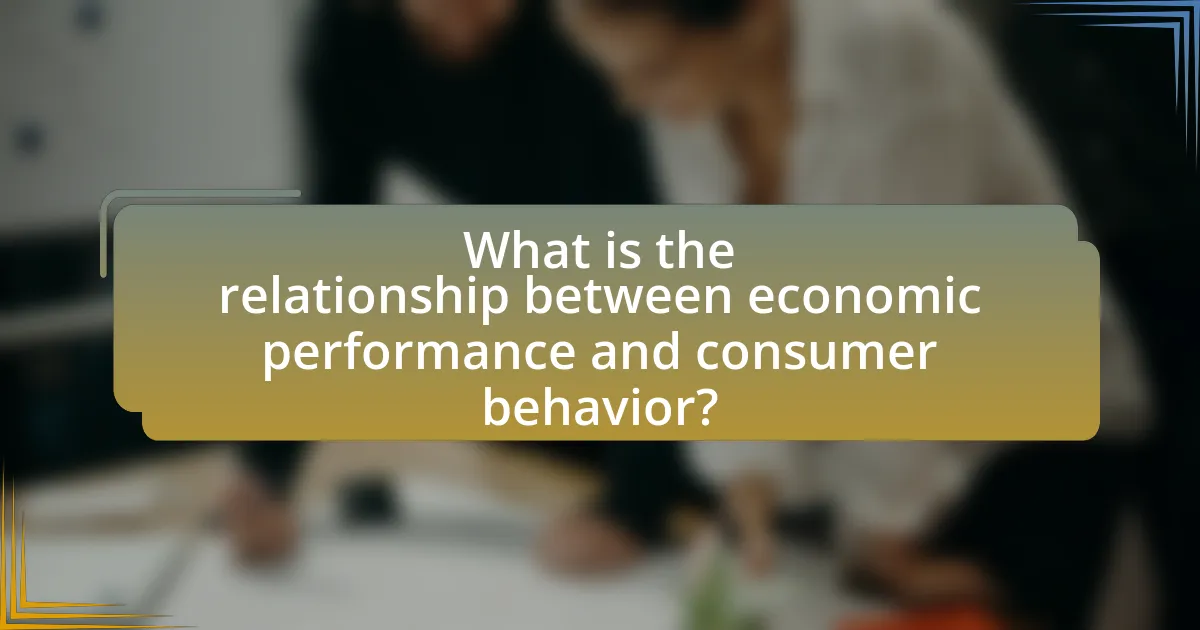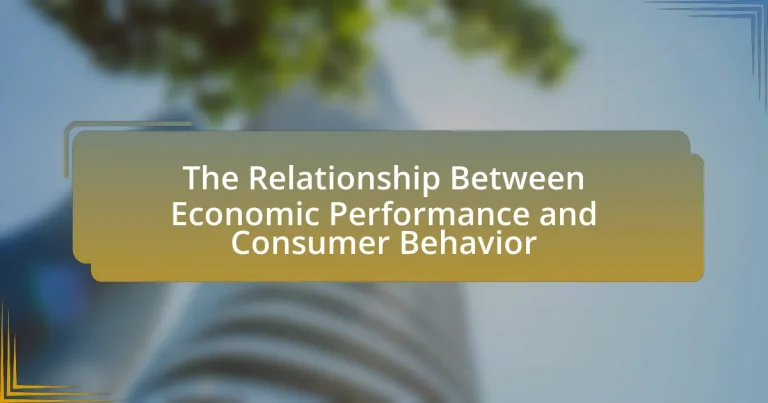The article examines the relationship between economic performance and consumer behavior, highlighting how economic growth influences consumer confidence and spending patterns. It discusses key economic indicators such as GDP, unemployment rates, and inflation, and their impact on consumer spending decisions. The article also explores how changes in economic conditions, including recessions and booms, affect consumer priorities and purchasing habits, emphasizing the importance of understanding consumer behavior for businesses to adapt their strategies effectively. Additionally, it addresses the psychological factors that shape consumer sentiment and the implications of these dynamics for economic performance and business practices.

What is the relationship between economic performance and consumer behavior?
Economic performance directly influences consumer behavior, as higher economic growth typically leads to increased consumer confidence and spending. When the economy is performing well, indicators such as rising GDP, low unemployment rates, and increased disposable income encourage consumers to spend more on goods and services. For instance, during periods of economic expansion, consumer spending can account for up to 70% of GDP in developed countries, demonstrating a strong correlation between economic health and consumer expenditure. Conversely, during economic downturns, consumer behavior shifts towards saving and reduced spending, reflecting a lack of confidence in future economic stability. This relationship is supported by data from the Bureau of Economic Analysis, which shows that consumer spending trends closely follow economic performance metrics.
How do economic indicators influence consumer spending?
Economic indicators significantly influence consumer spending by providing insights into the overall health of the economy. When indicators such as GDP growth, unemployment rates, and inflation are positive, consumer confidence typically increases, leading to higher spending. For instance, a low unemployment rate often correlates with increased disposable income, which encourages consumers to spend more on goods and services. Conversely, negative indicators, like rising inflation or high unemployment, can lead to decreased consumer confidence and reduced spending. Historical data shows that during economic downturns, such as the 2008 financial crisis, consumer spending dropped significantly as economic indicators worsened, demonstrating the direct relationship between these indicators and consumer behavior.
What are the key economic indicators that affect consumer behavior?
Key economic indicators that affect consumer behavior include gross domestic product (GDP), unemployment rates, inflation rates, and consumer confidence indices. GDP reflects the overall economic health and growth, influencing consumer spending; for instance, a rising GDP typically correlates with increased consumer expenditure. Unemployment rates indicate job availability and economic stability; higher unemployment often leads to reduced consumer spending due to decreased income. Inflation rates measure the rate at which prices rise, affecting purchasing power; for example, high inflation can lead to decreased consumer spending as individuals prioritize essential goods. Lastly, consumer confidence indices gauge consumer sentiment regarding the economy; higher confidence usually results in increased spending, while lower confidence can lead to cautious spending behavior.
How do changes in GDP impact consumer confidence?
Changes in GDP significantly impact consumer confidence, as higher GDP growth typically correlates with increased consumer optimism. When GDP rises, it often indicates a robust economy, leading consumers to feel more secure about their financial situation and future job prospects. For instance, during periods of economic expansion, such as the U.S. economic recovery post-2008 financial crisis, consumer confidence indices, like the Conference Board Consumer Confidence Index, showed marked increases alongside GDP growth rates, which reached over 3% annually in 2018. Conversely, declines in GDP can lead to heightened uncertainty and pessimism among consumers, as seen during recessions when GDP contracts, resulting in lower consumer spending and confidence levels.
Why is understanding consumer behavior important for economic performance?
Understanding consumer behavior is crucial for economic performance because it directly influences demand, which drives production and economic growth. When businesses comprehend consumer preferences, spending habits, and decision-making processes, they can tailor their products and marketing strategies effectively. For instance, a study by the American Marketing Association found that companies that leverage consumer insights can increase their sales by up to 20%. This alignment between consumer needs and business offerings leads to higher customer satisfaction, repeat purchases, and ultimately, a stronger economy.
How does consumer spending drive economic growth?
Consumer spending drives economic growth by increasing demand for goods and services, which in turn stimulates production and job creation. When consumers purchase products, businesses respond by ramping up production to meet this demand, leading to higher sales and revenue. For instance, in the United States, consumer spending accounts for approximately 70% of GDP, highlighting its critical role in economic performance. This increased economic activity can lead to more hiring, higher wages, and ultimately, a cycle of further spending, reinforcing the growth of the economy.
What role does consumer sentiment play in economic cycles?
Consumer sentiment significantly influences economic cycles by affecting consumer spending and investment decisions. When consumer sentiment is high, individuals are more likely to spend money, leading to increased demand for goods and services, which stimulates economic growth. Conversely, low consumer sentiment typically results in reduced spending, contributing to economic downturns. For instance, during the 2008 financial crisis, consumer confidence plummeted, leading to a sharp decline in consumer spending, which exacerbated the recession. This relationship is supported by data from the University of Michigan’s Consumer Sentiment Index, which correlates consumer sentiment with GDP growth rates, demonstrating that shifts in sentiment can predict economic performance.
What factors shape consumer behavior in different economic contexts?
Consumer behavior is shaped by factors such as income levels, economic stability, cultural influences, and market conditions. In high-income contexts, consumers tend to prioritize quality and brand reputation, while in low-income settings, price sensitivity becomes more pronounced. Economic stability influences consumer confidence; during recessions, consumers often reduce spending and prioritize essential goods. Cultural influences also play a significant role, as societal values and norms can dictate preferences and purchasing habits. For instance, in collectivist cultures, group consensus may drive buying decisions, whereas individualistic cultures may emphasize personal choice. Market conditions, including competition and availability of products, further impact consumer choices, as consumers adapt to the options presented to them.
How do income levels affect purchasing decisions?
Income levels significantly influence purchasing decisions by determining consumers’ ability to afford goods and services. Higher income levels typically enable consumers to purchase more luxury items and higher-quality products, while lower income levels often lead to prioritization of essential goods and budget-friendly options. For instance, a study by the Bureau of Labor Statistics indicates that households with higher incomes allocate a larger percentage of their budget to discretionary spending, such as travel and entertainment, compared to lower-income households, which focus more on necessities like food and housing. This correlation between income and spending patterns illustrates how economic performance directly shapes consumer behavior.
What impact do economic downturns have on consumer priorities?
Economic downturns significantly shift consumer priorities towards essential goods and services. During such periods, consumers typically reduce discretionary spending, focusing instead on necessities like food, housing, and healthcare. For instance, a study by the National Bureau of Economic Research found that during the 2008 financial crisis, consumer spending on non-essential items dropped by over 20%, while spending on essentials remained stable. This behavior reflects a fundamental change in priorities, driven by increased financial uncertainty and a need for security.

How does consumer behavior reflect economic conditions?
Consumer behavior reflects economic conditions through changes in spending patterns, saving rates, and purchasing decisions. During economic growth, consumers tend to spend more due to increased disposable income and confidence in job security, leading to higher demand for goods and services. Conversely, in times of economic downturn, such as recessions, consumers often reduce spending, prioritize essential purchases, and increase savings as a response to uncertainty and financial strain. For instance, data from the U.S. Bureau of Economic Analysis shows that during the 2008 financial crisis, consumer spending dropped significantly, illustrating a direct correlation between economic conditions and consumer behavior.
What trends can be observed in consumer spending during economic booms?
During economic booms, consumer spending typically increases significantly as disposable incomes rise and consumer confidence improves. This trend is evidenced by data from the U.S. Bureau of Economic Analysis, which shows that during periods of economic expansion, such as the post-2008 recovery, personal consumption expenditures grew at an annual rate of over 3% on average. Additionally, consumers tend to spend more on luxury goods, travel, and dining out, reflecting a shift towards discretionary spending. This behavior is supported by the increase in retail sales figures, which often rise sharply during economic upturns, indicating a willingness to spend on non-essential items.
How do luxury goods sales change in a thriving economy?
Luxury goods sales typically increase in a thriving economy due to higher disposable incomes and consumer confidence. As economic conditions improve, individuals and households experience greater financial stability, leading to increased spending on non-essential items, including luxury products. For instance, data from Bain & Company indicates that the global luxury market grew by 23% in 2021, reflecting a rebound in consumer spending as economies recovered from the pandemic. This trend demonstrates that when economic performance is strong, consumers are more willing to invest in luxury goods, driving sales upward.
What are the implications of increased consumer debt during economic growth?
Increased consumer debt during economic growth can lead to higher consumer spending, which may initially stimulate the economy. However, this reliance on debt can create vulnerabilities, such as increased financial strain on households and potential defaults if economic conditions change. For instance, during the economic expansion from 2010 to 2019, U.S. household debt rose significantly, contributing to a temporary boost in consumer spending but also raising concerns about long-term financial stability as debt-to-income ratios increased. This duality illustrates that while consumer debt can drive growth, it also poses risks that could undermine economic resilience.
How do recessions alter consumer behavior?
Recessions significantly alter consumer behavior by leading to reduced spending and increased savings. During economic downturns, consumers often prioritize essential goods over discretionary items, resulting in a shift towards budget-friendly options. For instance, a study by the National Bureau of Economic Research found that during the 2008 financial crisis, consumer spending on non-essential items dropped by approximately 20%. This behavior reflects heightened uncertainty and a focus on financial security, as individuals become more cautious about their expenditures.
What strategies do consumers adopt during economic downturns?
Consumers adopt several strategies during economic downturns, primarily focusing on cost-cutting and prioritizing essential purchases. Research indicates that during such periods, individuals tend to reduce discretionary spending, seek discounts, and switch to lower-cost alternatives. For instance, a study by the Bureau of Labor Statistics shows that during the 2008 financial crisis, consumer spending on non-essential goods dropped significantly, while spending on necessities remained stable. Additionally, consumers often increase their savings rates and may delay major purchases, reflecting a cautious approach to financial management in uncertain economic times.
How does unemployment influence consumer purchasing habits?
Unemployment significantly reduces consumer purchasing habits as individuals facing job loss tend to prioritize essential spending over discretionary purchases. When unemployment rates rise, disposable income decreases, leading consumers to cut back on non-essential items such as luxury goods and services. For instance, during the 2008 financial crisis, consumer spending fell by 3.1% as unemployment peaked at 10%, illustrating a direct correlation between rising unemployment and reduced consumer expenditure. This trend is supported by economic studies indicating that higher unemployment leads to increased savings rates and a shift towards more frugal spending behaviors, as consumers become more cautious about their financial future.
What psychological factors affect consumer behavior in relation to economic performance?
Psychological factors that affect consumer behavior in relation to economic performance include perception, motivation, beliefs, and attitudes. Perception influences how consumers interpret economic conditions, such as inflation or unemployment rates, which can affect their spending habits. For instance, during economic downturns, negative perceptions may lead to decreased consumer confidence, resulting in reduced spending. Motivation drives consumers to fulfill needs and desires, often influenced by economic performance; for example, higher disposable income can increase the motivation to purchase luxury goods. Beliefs about the economy, shaped by media and personal experiences, can also impact consumer behavior; optimistic beliefs may encourage spending, while pessimistic beliefs can lead to saving. Lastly, attitudes towards brands and products can shift based on economic conditions, affecting purchasing decisions. Research indicates that consumer sentiment, which reflects these psychological factors, correlates with economic indicators like GDP growth and unemployment rates, demonstrating the interconnectedness of psychology and economic performance.
How does fear of economic instability impact consumer spending?
Fear of economic instability leads to decreased consumer spending as individuals prioritize saving over discretionary purchases. When consumers perceive potential economic downturns, they often reduce expenditures on non-essential items, opting instead to build financial reserves. For instance, during the 2008 financial crisis, consumer spending fell by 3.1% in the U.S. as households faced uncertainty about job security and income stability. This behavior reflects a broader trend where economic anxiety prompts consumers to adopt a more cautious approach, impacting overall economic growth.
What role does brand loyalty play during economic fluctuations?
Brand loyalty serves as a stabilizing force during economic fluctuations, as loyal customers are more likely to continue purchasing from their preferred brands despite financial uncertainty. Research indicates that during economic downturns, consumers tend to prioritize familiar brands that they trust, leading to sustained sales for those brands. For instance, a study by the Harvard Business Review found that companies with strong brand loyalty can maintain their market share even when overall consumer spending declines. This loyalty mitigates the impact of economic challenges, as loyal customers are less price-sensitive and more inclined to stick with brands they know, thereby providing a buffer against fluctuating economic conditions.

What are the implications of the relationship between economic performance and consumer behavior for businesses?
The relationship between economic performance and consumer behavior significantly impacts businesses by influencing their sales strategies and market positioning. When economic performance is strong, consumers tend to have higher disposable incomes, leading to increased spending on goods and services. For instance, during periods of economic growth, such as the U.S. expansion from 2009 to 2020, consumer spending rose, prompting businesses to invest in inventory and marketing to capitalize on this demand. Conversely, during economic downturns, like the 2008 financial crisis, consumer confidence declines, resulting in reduced spending and forcing businesses to adjust their pricing strategies and operational costs to maintain profitability. This dynamic illustrates that businesses must continuously analyze economic indicators and consumer sentiment to adapt their strategies effectively, ensuring they meet changing consumer needs and preferences.
How can businesses adapt to changing consumer behavior in different economic climates?
Businesses can adapt to changing consumer behavior in different economic climates by implementing flexible pricing strategies, enhancing customer engagement, and leveraging data analytics. Flexible pricing allows businesses to adjust their prices based on consumer demand and economic conditions, which is crucial during economic downturns when consumers are more price-sensitive. For example, during the 2008 financial crisis, many retailers offered discounts and promotions to attract budget-conscious shoppers, resulting in increased sales despite the economic challenges.
Enhancing customer engagement through personalized marketing and improved customer service can also help businesses retain loyalty and adapt to shifting preferences. A study by McKinsey & Company found that companies that prioritized customer experience saw a 20% increase in customer satisfaction and loyalty during economic fluctuations.
Leveraging data analytics enables businesses to track consumer trends and preferences in real-time, allowing for timely adjustments to product offerings and marketing strategies. According to a report by Deloitte, organizations that utilize data-driven decision-making are 5-6 times more likely to be profitable than their competitors. By focusing on these strategies, businesses can effectively navigate the complexities of changing consumer behavior across various economic climates.
What marketing strategies are effective during economic downturns?
Effective marketing strategies during economic downturns include focusing on value-driven messaging, enhancing customer engagement, and leveraging digital channels. Value-driven messaging emphasizes affordability and quality, which resonates with consumers looking to maximize their spending. For instance, brands like Walmart have successfully thrived during recessions by promoting low prices and essential goods. Enhancing customer engagement through personalized communication and loyalty programs can foster brand loyalty, as seen with companies like Starbucks, which maintained customer connections through targeted promotions. Additionally, leveraging digital channels allows businesses to reach consumers cost-effectively; during the 2008 financial crisis, companies that increased their digital marketing efforts, such as online advertising and social media engagement, often saw better retention and sales performance.
How can businesses leverage consumer insights to improve economic performance?
Businesses can leverage consumer insights to improve economic performance by analyzing customer preferences and behaviors to tailor products and marketing strategies effectively. By utilizing data analytics tools, companies can identify trends and patterns in consumer behavior, enabling them to make informed decisions that align with market demands. For instance, a study by McKinsey & Company found that organizations that prioritize customer insights can achieve a 10-15% increase in revenue. This approach allows businesses to enhance customer satisfaction, foster loyalty, and ultimately drive sales growth, leading to improved economic performance.
What best practices should businesses follow to align with consumer behavior trends?
Businesses should adopt data-driven strategies to align with consumer behavior trends. By utilizing analytics tools, companies can gather insights on purchasing patterns, preferences, and emerging trends. For instance, a study by McKinsey & Company found that organizations leveraging customer data effectively can increase their profitability by 15-20%. Additionally, businesses should prioritize personalization in marketing efforts, as 80% of consumers are more likely to make a purchase when brands offer personalized experiences. Engaging with consumers through social media and feedback channels also fosters a deeper understanding of their needs, enabling businesses to adapt quickly to changing preferences.
How can businesses use data analytics to understand consumer behavior better?
Businesses can use data analytics to understand consumer behavior better by analyzing purchasing patterns, preferences, and trends through various data sources. By leveraging tools such as customer segmentation, predictive analytics, and sentiment analysis, companies can gain insights into what drives consumer decisions. For instance, a study by McKinsey & Company found that organizations using advanced analytics can improve their marketing ROI by 15-20% by tailoring their strategies based on consumer insights. This data-driven approach allows businesses to optimize their offerings, enhance customer experiences, and ultimately drive economic performance.
What role does customer feedback play in shaping business strategies during economic changes?
Customer feedback plays a critical role in shaping business strategies during economic changes by providing insights into consumer preferences and needs. This feedback allows businesses to adapt their offerings and marketing strategies to align with shifting market conditions. For instance, during economic downturns, companies that actively solicit and analyze customer feedback can identify cost-saving measures or product adjustments that resonate with consumers, thereby maintaining customer loyalty and market relevance. Research from the Harvard Business Review indicates that organizations that prioritize customer feedback are 60% more likely to achieve their strategic goals during economic fluctuations, demonstrating the tangible impact of consumer insights on business adaptability and success.
What practical tips can businesses implement to thrive in varying economic conditions?
Businesses can thrive in varying economic conditions by diversifying their product offerings and maintaining a flexible pricing strategy. Diversification allows companies to reduce dependency on a single revenue stream, which is crucial during economic downturns; for instance, companies like Amazon have successfully expanded into various sectors, mitigating risks associated with market fluctuations. A flexible pricing strategy enables businesses to adjust prices based on consumer demand and economic conditions, as seen in the airline industry, where dynamic pricing models help optimize revenue during peak and off-peak seasons. Additionally, investing in customer relationship management can enhance loyalty and retention, providing stability in uncertain times.


